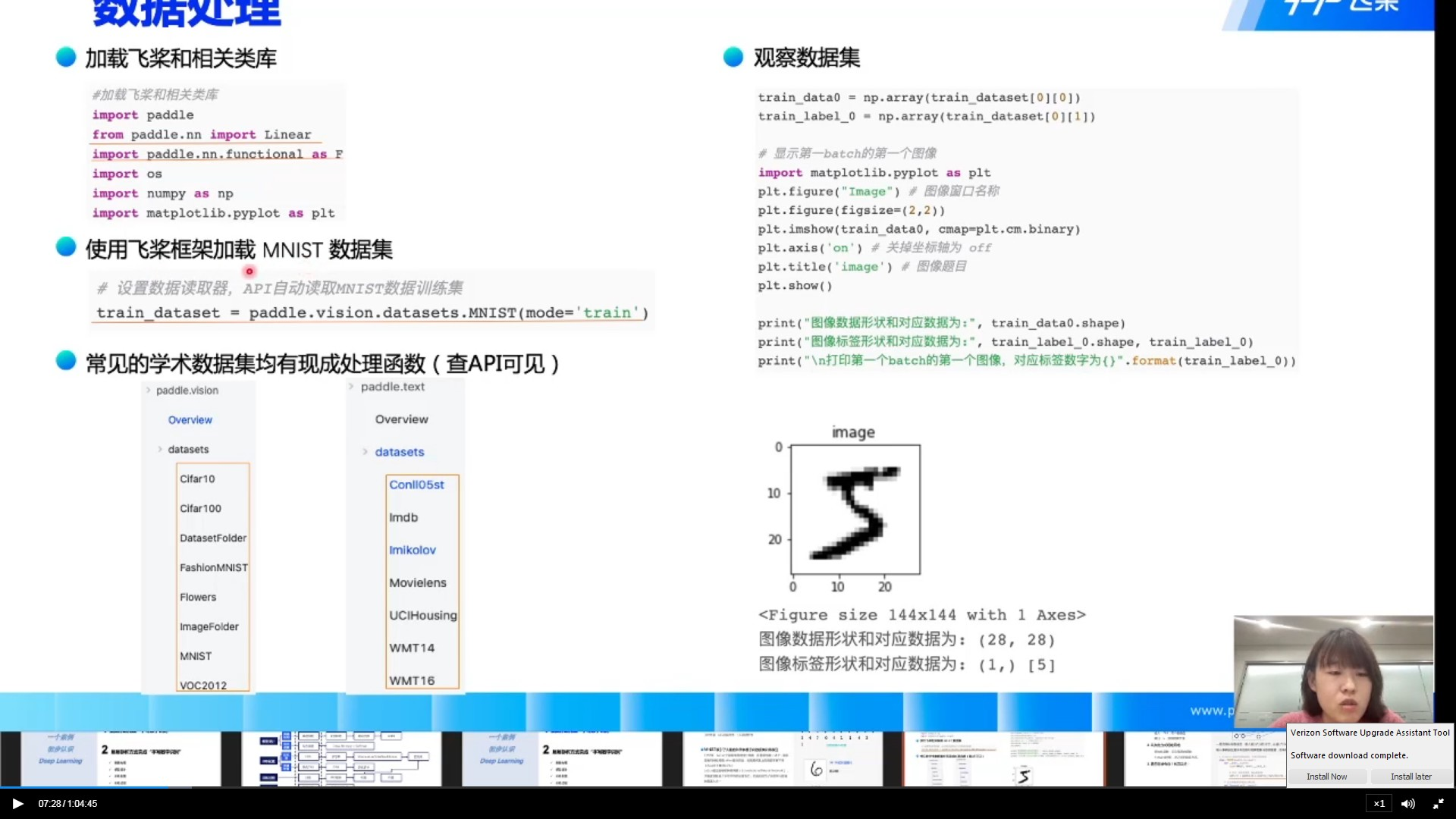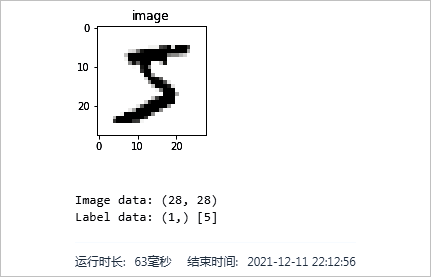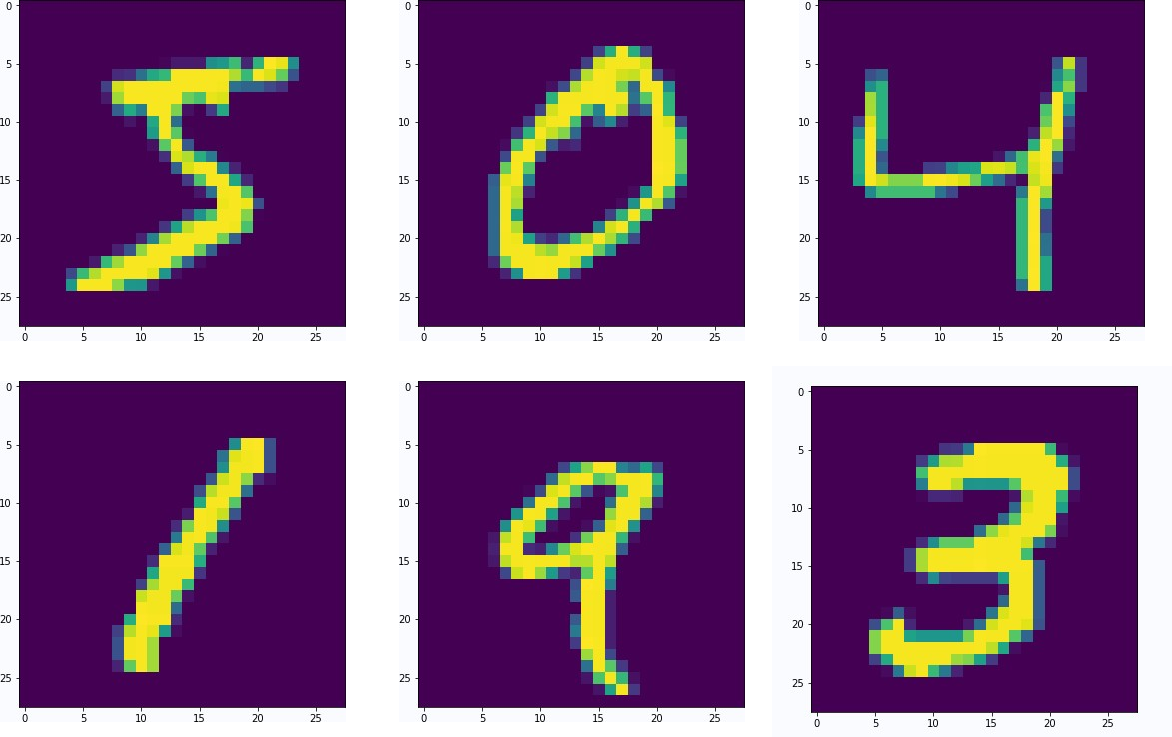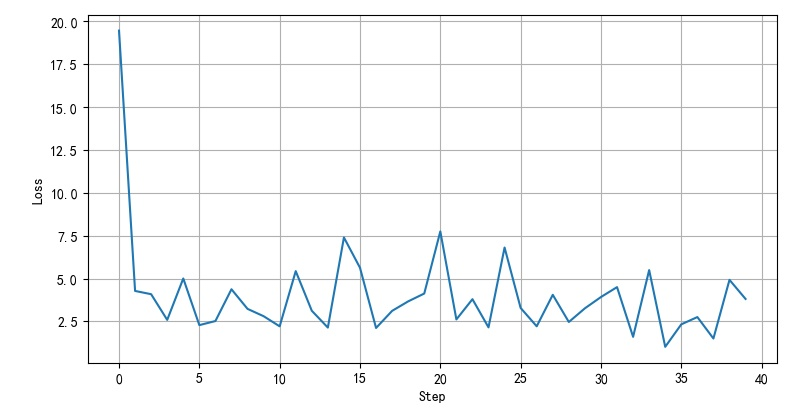
Introduction: ※ identify MNIST program by testing this minimalist Paddle on the network, that is, use a very simple linear regression network, and preliminarily get familiar with the network architecture under Paddle. An example is also given in the tensor conversion program from numpy to Paddle.
Keywords: AI Studio, paddy, MNIST
§ 01 establishment works
Establish a NoteBook based engineering environment in AI Studio and select the MNIST database.
stay Where can I find the final version of the sample program? AI Studio-MNIST Experiment with MNIST database based on the paddy framework in AI Studio. Firstly, the minimalist test method is tested. However, some problems have been encountered in the process.
Later, after inquiry, we can know that the code in the book is slow to publish, so the AI Studio code in the class has been upgraded. Suggestion or observation AI Studio handwritten numeral recognition case , test according to the code in it.

1, Call in database
import matplotlib.pyplot as plt from numpy import * import math,time import paddle from paddle.nn import Linear import paddle.nn.functional as F import os train_dataset = paddle.vision.datasets.MNIST(mode='train')
import paddle
from paddle.nn import Linear
import paddle.nn.functional as F
import os
train_dataset = paddle.vision.datasets.MNIST(mode='train')
train_data0 = array(train_dataset[0][0])
train_label0 = array(train_dataset[0][1])
plt.figure('Image')
plt.figure(figsize=(5,5))
plt.imshow(train_data0, cmap=plt.cm.binary)
plt.axis('on')
plt.title('MNIST image')
plt.show()
print('Image shape: {}'.format(train_data0.shape))
print('Image label shape: {} and data: {}'.format(train_label0.shape, train_label0))


2. Common academic data sets
In the pad vision. There are some common academic data sets in datasets.
(1)paddle. Data set in vision
dir(paddle.vision.datasets)
['Cifar10', 'Cifar100', 'DatasetFolder', 'FashionMNIST', 'Flowers', 'ImageFolder', 'MNIST', 'VOC2012', '__all__', '__builtins__', '__cached__', '__doc__', '__file__', '__loader__', '__name__', '__package__', '__path__', '__spec__', 'cifar', 'flowers', 'folder', 'mnist', 'voc2012']
(2)paddle. Textdata set
dir(paddle.text.datasets)
['Conll05st', 'Imdb', 'Imikolov', 'Movielens', 'UCIHousing', 'WMT14', 'WMT16', '__all__', '__builtins__', '__cached__', '__doc__', '__file__', '__loader__', '__name__', '__package__', '__path__', '__spec__', 'conll05', 'imdb', 'imikolov', 'movielens', 'uci_housing', 'wmt14', 'wmt16']
2, Minimalist Engineering
1. Model building
class MNIST(paddle.nn.Layer):
def __init__(self, ):
super(MNIST, self).__init__()
self.fc = paddle.nn.Linear(in_features=784, out_features=1)
def forward(self, inputs):
outputs = self.fc(inputs)
return outputs
def norm_img(img):
assert len(img.shape) == 3
batch_size, img_h, img_w = img.shape[0], img.shape[1], img.shape[2]
img = img/255
img = paddle.reshape(img, [batch_size, img_h*img_w])
return img
import paddle
paddle.vision.set_image_backend('cv2')
def train(model):
model.train()
train_loader = paddle.io.DataLoader(paddle.vision.datasets.MNIST(mode='train'),
batch_size=16,
shuffle=True)
opt = paddle.optimizer.SGD(learning_rate=0.001, parameters=model.parameters())
EPOCH_NUM = 10
for epoch in range(EPOCH_NUM):
for batch_id, data in enumerate(train_loader()):
images = norm_img(data[0]).astype('float32')
labels = data[1].astype('float32')
predicts = model(images)
loss = F.square_error_cost(predicts, labels)
avg_loss = paddle.mean(loss)
if batch_id%1000 == 0:
print('epoch_id: {}, batch_id: {}, loss is: {}'.format(epoch, batch_id, avg_loss.numpy()))
avg_loss.backward()
opt.step()
opt.clear_grad()
2. Training model
model = MNIST() train(model) paddle.save(model.state_dict(), './mnist.pdparms')
3. Training results
epoch_id: 0, batch_id: 0, loss is: [19.446383] epoch_id: 0, batch_id: 1000, loss is: [4.280066] epoch_id: 0, batch_id: 2000, loss is: [4.089441] epoch_id: 0, batch_id: 3000, loss is: [2.5934415] epoch_id: 1, batch_id: 0, loss is: [5.005641] epoch_id: 1, batch_id: 1000, loss is: [2.2887247] epoch_id: 1, batch_id: 2000, loss is: [2.5260096] epoch_id: 1, batch_id: 3000, loss is: [4.377707] epoch_id: 2, batch_id: 0, loss is: [3.2349763] epoch_id: 2, batch_id: 1000, loss is: [2.8085265] epoch_id: 2, batch_id: 2000, loss is: [2.2175798] epoch_id: 2, batch_id: 3000, loss is: [5.4343185] epoch_id: 3, batch_id: 0, loss is: [3.1255033] epoch_id: 3, batch_id: 1000, loss is: [2.1449356] epoch_id: 3, batch_id: 2000, loss is: [7.3950243] epoch_id: 3, batch_id: 3000, loss is: [5.631453] epoch_id: 4, batch_id: 0, loss is: [2.1221619] epoch_id: 4, batch_id: 1000, loss is: [3.1189494] epoch_id: 4, batch_id: 2000, loss is: [3.672319] epoch_id: 4, batch_id: 3000, loss is: [4.128253] epoch_id: 5, batch_id: 0, loss is: [7.7472067] epoch_id: 5, batch_id: 1000, loss is: [2.6192496] epoch_id: 5, batch_id: 2000, loss is: [3.7988458] epoch_id: 5, batch_id: 3000, loss is: [2.1571586] epoch_id: 6, batch_id: 0, loss is: [6.8091993] epoch_id: 6, batch_id: 1000, loss is: [3.2879863] epoch_id: 6, batch_id: 2000, loss is: [2.2202625] epoch_id: 6, batch_id: 3000, loss is: [4.0542073] epoch_id: 7, batch_id: 0, loss is: [2.4702597] epoch_id: 7, batch_id: 1000, loss is: [3.267303] epoch_id: 7, batch_id: 2000, loss is: [3.925469] epoch_id: 7, batch_id: 3000, loss is: [4.502317] epoch_id: 8, batch_id: 0, loss is: [1.6059736] epoch_id: 8, batch_id: 1000, loss is: [5.4941883] epoch_id: 8, batch_id: 2000, loss is: [1.0239292] epoch_id: 8, batch_id: 3000, loss is: [2.333592] epoch_id: 9, batch_id: 0, loss is: [2.7579784] epoch_id: 9, batch_id: 1000, loss is: [1.5081773] epoch_id: 9, batch_id: 2000, loss is: [4.925281] epoch_id: 9, batch_id: 3000, loss is: [3.8142138]

4. Test model
(1) View test set results
for batch_id, data in enumerate(test_loader()):
images = norm_img(data[0]).astype('float32')
labels = data[1].astype('float32')
predicts = model(images)
loss = F.square_error_cost(predicts, labels)
avg_loss = paddle.mean(loss)
print(predicts)
print(labels)
print(loss)
print(avg_loss)
break
Operation results
Tensor(shape=[16, 1], dtype=float32, place=CPUPlace, stop_gradient=False,
[[2.06245565],
[1.97789598],
[5.32851791],
[2.76517129],
[4.77754116],
[1.96410847],
[1.70493352],
[2.46705198],
[7.93237495],
[5.77034092],
[4.87852144],
[0.48723245],
[4.39118719],
[1.38979697],
[1.77543545],
[1.47215056]])
Tensor(shape=[16, 1], dtype=float32, place=CPUPlace, stop_gradient=True,
[[0.],
[1.],
[5.],
[5.],
[6.],
[1.],
[1.],
[1.],
[7.],
[4.],
[2.],
[0.],
[1.],
[1.],
[0.],
[1.]])
Tensor(shape=[16, 1], dtype=float32, place=CPUPlace, stop_gradient=False,
[[4.25372314],
[0.95628053],
[0.10792402],
[4.99445915],
[1.49440563],
[0.92950511],
[0.49693128],
[2.15224147],
[0.86932307],
[3.13410687],
[8.28588581],
[0.23739545],
[11.50015068],
[0.15194169],
[3.15217113],
[0.22292615]])
Tensor(shape=[1], dtype=float32, place=CPUPlace, stop_gradient=False,
[2.68371058])
(2) Test prediction results
def showimg(img):
imgdata = img.numpy()
print(imgdata.shape)
imgblock = [i.reshape([28,28]) for i in imgdata]
imgb1 = concatenate(imgblock[:8], axis=1)
imgb2 = concatenate(imgblock[8:], axis=1)
imgb = concatenate((imgb1, imgb2))
plt.figure(figsize=(10,10))
plt.imshow(imgb)
plt.axis('off')
plt.show()

Forecast results:
for batch_id, data in enumerate(test_loader()):
showimg(images)
predicts = model(images)
print(labels.numpy().flatten().T)
print([p for p in predicts.numpy().flatten().T])
| 3. | 9. | 4. | 3. | 0. | 7. | 0. | 9. | 9. | 5. | 6. | 7. | 1. | 7. | 0. | 0. |
|---|---|---|---|---|---|---|---|---|---|---|---|---|---|---|---|
| 3.3602648 | 8.111923 | 5.3560495 | 5.2887278 | 4.218868 | 5.3987856 | 2.5647051 | 8.387244 | 8.198596 | 3.977576 | 3.7429187 | 7.7407055 | 6.2851562 | 4.435977 | 2.9352028 | 3.7802896 |
5. Network reference program
import paddle
from paddle.nn import Linear
import paddle.nn.functional as F
import os
import numpy as np
import matplotlib.pyplot as plt
train_dataset = paddle.vision.datasets.MNIST(mode='train')
train_data0 = np.array(train_dataset[0][0])
train_label_0 = np.array(train_dataset[0][1])
import matplotlib.pyplot as plt
plt.figure("Image") # Image window name
plt.figure(figsize=(2,2))
plt.imshow(train_data0, cmap=plt.cm.binary)
plt.axis('on') # The coordinate axis is off
plt.title('image') # Image title
plt.show()
print("The image data shape and corresponding data are:", train_data0.shape)
print("The image label shape and corresponding data are:", train_label_0.shape, train_label_0)
print("\n Print first batch The first image of the corresponding label number is{}".format(train_label_0))
class MNIST(paddle.nn.Layer):
def __init__(self):
super(MNIST, self).__init__()
# Define a full connection layer, and the output dimension is 1
self.fc = paddle.nn.Linear(in_features=784, out_features=1)
# Define the forward calculation process of the network structure
def forward(self, inputs):
outputs = self.fc(inputs)
return outputs
model = MNIST()
def train(model):
# Start training mode
model.train()
# Load training set batch_ Set size to 16
train_loader = paddle.io.DataLoader(paddle.vision.datasets.MNIST(mode='train'),
batch_size=16,
shuffle=True)
# Define the optimizer, use the random gradient descent SGD optimizer, and set the learning rate to 0.001
opt = paddle.optimizer.SGD(learning_rate=0.001, parameters=model.parameters())
def norm_img(img):
# Verify whether the incoming data format is correct. The shape of img is [batch_size, 28, 28]
assert len(img.shape) == 3
batch_size, img_h, img_w = img.shape[0], img.shape[1], img.shape[2]
# Normalized image data
img = img / 255
# reshape the image as [batch_size, 784]
img = paddle.reshape(img, [batch_size, img_h*img_w])
return img
import paddle
paddle.vision.set_image_backend('cv2')
model = MNIST()
def train(model):
# Start training mode
model.train()
# Load training set batch_ Set size to 16
train_loader = paddle.io.DataLoader(paddle.vision.datasets.MNIST(mode='train'),
batch_size=16,
shuffle=True)
# Define the optimizer, use the random gradient descent SGD optimizer, and set the learning rate to 0.001
opt = paddle.optimizer.SGD(learning_rate=0.001, parameters=model.parameters())
EPOCH_NUM = 10
for epoch in range(EPOCH_NUM):
for batch_id, data in enumerate(train_loader()):
images = norm_img(data[0]).astype('float32')
labels = data[1].astype('float32')
#Forward calculation process
predicts = model(images)
# Calculate loss
loss = F.square_error_cost(predicts, labels)
avg_loss = paddle.mean(loss)
#Print the current Loss for every 1000 batches of data trained
if batch_id % 1000 == 0:
print("epoch_id: {}, batch_id: {}, loss is: {}".format(epoch, batch_id, avg_loss.numpy()))
#Backward propagation, the process of updating parameters
avg_loss.backward()
opt.step()
opt.clear_grad()
train(model)
paddle.save(model.state_dict(), './mnist.pdparams')
import matplotlib.pyplot as plt
import numpy as np
from PIL import Image
img_path = './work/download.png'
im = Image.open('./work/download.png')
plt.imshow(im)
plt.show()
im = im.convert('L')
print('original image shape: ', np.array(im).shape)
im = im.resize((28, 28), Image.ANTIALIAS)
plt.imshow(im)
plt.show()
print("Picture after sampling shape: ", np.array(im).shape)
def load_image(img_path):
# From img_path to read the image and convert it into a grayscale image
im = Image.open(img_path).convert('L')
# print(np.array(im))
im = im.resize((28, 28), Image.ANTIALIAS)
im = np.array(im).reshape(1, -1).astype(np.float32)
# The image is normalized to keep consistent with the data range of the data set
im = 1 - im / 255
return im
model = MNIST()
params_file_path = 'mnist.pdparams'
img_path = './work/download.png'
param_dict = paddle.load(params_file_path)
model.load_dict(param_dict)
model.eval()
tensor_img = load_image(img_path)
result = model(paddle.to_tensor(tensor_img))
print('result',result)
print("The forecast figure is", result.numpy().astype('int32'))
※ identification summary ※
By testing the minimalist pad on the network to identify the MNIST program, that is, using a very simple linear regression network, I am preliminarily familiar with the network architecture under pad. An example is also given in the tensor conversion program from numpy to Paddle.
1, Data conversion
1. From numpy to tensor
paddle.to_tensor()
2. From tensor to numpy
data.numpy()
■ links to relevant literature:
- Where can I find the final version of the sample program? AI Studio-MNIST
- AI Studio handwritten numeral recognition case
● relevant chart links: